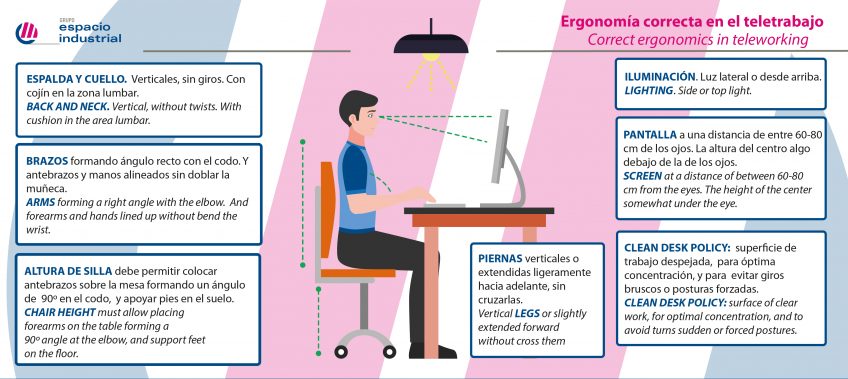Decalogue of correct ergonomics in teleworking
The Department of Occupational Risk Prevention of Grupo Espacio Industrial has developed an ergonomics decalogue for people who began to telework from their home due to the health crisis caused by the coronavirus.
Basically, these are recommendations to check the correct position of the seat and all the elements of the desk, to alert about dangerous postures, as well as to remember the importance of getting up periodically and performing stretching exercises and eye relaxation.
Staying for many hours in the wrong posture can lead to lumbar strain, muscle aches and even joint injuries. Therefore, even if you are working at home, it is important to adapt your workplace to your needs, in terms of chair and desk height, computer screen, lighting, etc.
1.- Chair and table height. Once seated, check that the forearms can be placed on the table at an angle of 90º at the elbow, and that the height of the seat allows you to rest your feet on the floor. Normally, office chairs can be adjusted in height and allow the body to be positioned at the right height, unlike the chairs at home. You have to find at home the one that best suits your needs.
2.- Screen position. The computer screen should be between 60 and 80 cm from the eyes (never below 40 cm). The height of the center of the screen should be slightly below eye level. If the screen is not height adjustable, you can put one or two thick books under your foot. Those who use laptops should take special care, since their screens are below the recommended height, forcing them to lower their eyes and bend their cervicals forward.
3.- Back and neck. They are the points that generate the greatest number of ailments. The trunk should be in a vertical position, without turns (screen just in front) and the line of sight parallel to the horizontal plane so as not to lower the chin. Office chairs typically have some curvature for lumbar support. If considered necessary, a cushion can be used in this area, in the house chair.
4.- Arms. The arms should be vertical and the forearms horizontal on the table, forming a right angle at the elbow. The forearms and hands should be aligned on the same axis without bending the wrist. Also, they should be relaxed, without forcing the posture. Incorrect postures on the keyboard or with the mouse can cause carpal tunnel syndrome.
5.- Legs. The thighs on the seat and the legs vertical or slightly extended forward. The feet should be resting on the ground. In addition, crossing the legs should be avoided so that strange vascularizations do not occur.
6.- Lighting. If working with natural light (recommended), the workstation must be placed parallel to the window so that the light enters from the side. It is always best if the light comes from the side or from above, to avoid glare or shadows on the screen and glare. It is convenient to regulate its intensity with the use of blinds and / or curtains.
7.- Clean Desk Policy. A clear surface of unnecessary equipment or accessories favors concentration. If paper documents or notebooks are used, they will be placed on the sides of the keyboard, avoiding sudden neck twists or continued forced postures.
8.- Get up. It is convenient to get up every half hour to stretch your legs and move your body. In Spain, the RD of 1997 regulates the work with PVDS (Data Visualization Screen) and recommends getting up every two hours and making a periodic break. At home, where the means of work are not those of the office, this time must be reduced. About 5 minutes rest and a short walk down the hall are enough.
9.- Mobility exercises. It is recommended to do mobility exercises before, during and after the day, in order to mobilize the segments of the spine (cervical, dorsal and lumbar), as well as the extremities. They should be exercises aimed at relaxing the neck and the upper power train (shoulder-arm-wrist-hand), and also the lumbar region and the lower power train (hip-gluteus-leg-foot).
10.- Eye exercises. Eye relaxation exercises are also highly recommended. It is convenient to fix your sight at a distant point, for about 10 seconds to vary the focus of the eye and relax your muscles. It also helps to completely cover your eyes with your hands for a few seconds to prevent light from entering.




